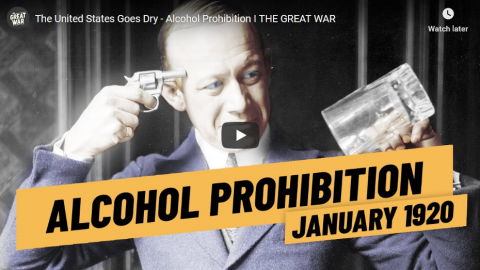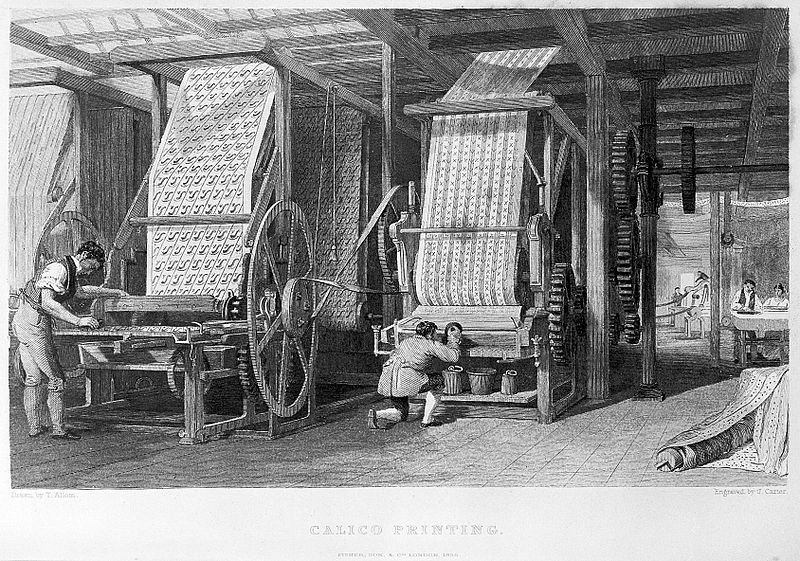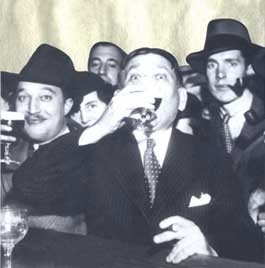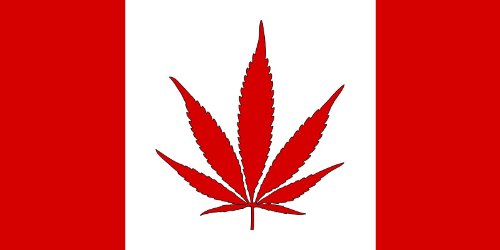Prohibition only makes things worse, like when alcohol Prohibition turned us from a peaceful nation of wine and beer drinkers into a crazed culture going blind on bathtub gin while the distributors shot each other down with Tommy-guns in the streets.
Vin Suprynowicz, “On Reporters Who Ask No (Unapproved) Questions”, Libertarian Enterprise, 2018-06-03.
September 2, 2020
QotD: Prohibition
January 21, 2020
The United States Goes Dry – Alcohol Prohibition I THE GREAT WAR
The Great War
Published 20 Jan 2020In January 1920, after one year of preparation, the 18th Amendment to the US Constitution went into effect. From now on alcohol prohibition was the law.
» SUPPORT THE CHANNEL
Patreon: https://www.patreon.com/thegreatwar
Merchandise: https://shop.spreadshirt.de/thegreatwar/» SOURCES
Ehmer, K. and Hindermann, B. (2015). The School of Sophisticated Drinking. New York: Greystone Books.
Miron and Zwiebel, “Alcohol Consumption During Prohibition”. In the American Economic Review, Vol. 81, No. 2, pp. 242-247, (May 1991).
Darrow, Clarence, and John Haynes Holmes. Debate On Prohibition. Haldeman-Julius Co., 1924.
Iorizzo, Luciano J. Al Capone. Greenwood Press, 2003.
Nemtsov, Aleksandr. A Contemporary History of Alcohol in Russia. Stockholm, 2011.
Sullivan, Edward D. Rattling the Cup on Chicago Crime. New York: The Vangaurd Press, 1929.
United States Government, “Codification of Internal Revenue Laws, … Published Pursuant to Section 1203(c) Revenue Act of 1926”.
18th Amendment to the Constitution of the United States. https://www.loc.gov/rr/program/bib/ou…
United States Department of Agriculture. “Crop Production Historical Track Records, 2018”. https://www.nass.usda.gov/Publication…
Kamieński, Łukasz: “Drugs”, in: 1914-1918-online. International Encyclopedia of the First World War, ed. by Ute Daniel, Peter Gatrell, Oliver Janz, Heather Jones, Jennifer Keene, Alan Kramer, and Bill Nasson, issued by Freie Universität Berlin, Berlin 2019-03-07
Blocker, Jack S Jr. “Did prohibition really work? Alcohol prohibition as a public health innovation.” American Journal of Public Health vol. 96,2 (2006): 233-43.» SOCIAL MEDIA
Instagram: https://instagram.com/the_great_war
Twitter: https://twitter.com/WW1_Series
Reddit: https://reddit.com/r/TheGreatWarChannel»CREDITS
Presented by: Jesse Alexander
Written by: Mark Newton
Director: Toni Steller & Florian Wittig
Director of Photography: Toni Steller
Sound: Toni Steller
Editing: Toni Steller
Mixing, Mastering & Sound Design: http://above-zero.com
Maps: Daniel Kogosov (https://www.patreon.com/Zalezsky)
Research by: Jesse Alexander
Fact checking: Florian WittigChannel Design: Alexander Clark
Original Logo: David van StepholdA Mediakraft Networks Original Channel
Contains licensed material by getty images
All rights reserved – Real Time History GmbH 2020
July 17, 2019
QotD: “The United States government [became] the greatest and most potent maker of criminals in any recent century”
For most of the history of the United States, drugs were legal. People could buy opiates and cocaine-based products from their local pharmacy. An opiate-laced brew called Mrs. Winslow’s Soothing Syrup, for example, was particularly popular with housewives. One person who viewed this legal system with skepticism was a Los Angeles doctor named Henry Smith Williams. When a small number of his patients became addicted, he was disgusted, and he came to see them as despicable “weaklings.” So when opiates and cocaine were banned in 1914, he welcomed this first birth-pang of the drug war with glee.
But then he noticed what happened to his addicted patients. They didn’t stop using. Instead, “here were tens of thousands of people, in every walk of life, frantically craving drugs that they could in no legal way secure,” he wrote in one of his books. “They craved the drugs, as a man dying of thirst craves water. They must have the drugs at any hazard, at any cost.”
At the same time, Smith Williams realized that the drug war was “in effect ordering a company of drug smugglers into existence.” Because pharmacists could no longer sell these drugs, the Mafia and other criminal organizations stepped in, selling a vastly inferior product at extortionate prices. In the pharmacies, morphine had cost two or three cents a grain, but the criminal gangs charged a dollar.
The death rate among addicts rose, and those who survived began to behave very differently. An official government study had found that, before the drug war kicked in, three-quarters of self-described addicts had steady and respectable jobs: some 22% were wealthy, while only 6% were poor. They were more sedate as a result of their addiction, but they were rarely out of control or criminal. Yet faced with the need to meet these extortionate new prices, many of the men started to commit property crimes, and many of the women started to steal or prostitute themselves.
So Smith Williams watched as the drug war created two waves of crime: first a wave of violent criminal drug-dealers, and then a wave of criminality among addicts. “The United States government,” Henry wrote in shock, had become “the greatest and most potent maker of criminals in any recent century.”
Johann Hari, “A 1930s California story shows why the war on drugs is a failure”, Los Angeles Times, 2017-06-16.
April 4, 2019
QotD: Anti-masculinity
One of the many harms inflicted on us by the hive minded lunatics running our society is the binary world view. Everything is either all good or all bad. As such, everyone must either fully embrace something or completely reject something. Indifference, ambivalence and moderation are not permissible in a world run by zealous fanatics. The only things that matter, that can matter, are those things that require a moral position. Everything else falls outside the set of things that exist, at least to the hive minded.
The most obvious example is homosexuality. Like all normal men, I am mildly intolerant of homosexuals. I get that they cannot help themselves and I get that it is “natural” in the same way schizophrenia is natural. I’m fine with them doing what they must, just as long as they do it in private. Of course, that makes me a monster. In the hive, you must either fully embrace homosexuality and what comes with it, or you are a homophobe and not fit for decent company. There’s no room for indifference or mild intolerance.
Hive mindedness is much more of a female attribute, than a masculine one. That’s not to imply that all women are howling at the moon zealots. It’s just that the fairer sex is much more inclined to deal in absolutes. The reason is that men have ways to arbitrate disputes that do not require a transcendent set of rules. One chimp squares off with the other chimp and the winner is the one who was right about where to find the best bananas. Women don’t have that so they look for a set of rules to figure out winners and losers.
It’s why it was no accident, that as soon as the girls got the vote, and the boys were off fighting the Kaiser, the girls banned alcohol and prostitution. To quote Judge Roy Bean, “Drinking and gambling and whoring were declared unlawful. All those things which come natural to men became crimes.” Morality, at least in the modern age, is the set of rules the girls use to control the boys, which is why the prim-faced moralizers of today are running around trying to stamp out anything that smacks of masculinity.
“The Z Man”, “Pouf-berries”, The Z Blog, 2017-04-08.
February 18, 2019
QotD: Patton and Prohibition
Observance of Prohibition in the breech was also common amongst junior officers. While commanding tank battalions and living next door to one another in renovated barracks at Camp Meade, Maryland, Dwight Eisenhower and George Patton avidly partook in the new American pastime of making their own bootleg alcohol. Eisenhower distilled gin in an unused bathtub, while Patton brewed beer, storing it in a shed outside his kitchen. One summer evening there was a sudden noise outside the Pattons’ barracks that sounded like a machine gun, followed by a series of soft booms. As their cook began screaming, Patton instinctively dove for cover. When they realized it was merely the beer bottles exploding from the heat, he rose, sheepishly explaining how much it had sounded like hostile fire. His wife Beatrice “laughed and laughed and called him ‘her hero’ and he got very red.” Omar Bradley commanded an infantry battalion in the 27th Infantry Regiment in the 1920s and took advantage of the Hawaii Division’s leisurely pace of duty to play golf several times a week. At the end of one round, the 33-year-old teetotaler drank his first glass of whiskey, which he liked enough to make “a habit of having a bourbon and water or two (but never more) before dinner” for the rest of his life.
Benjamin Runkle, “‘What a Magnificent Body of Men Never to Take Another Drink’: The U.S. Army and Prohibition”, Real Clear Defense, 2019-01-16.
January 4, 2019
The US Turns Away from the World to Prohibition and Crime I Between 2 Wars I 1921 Part 1 of 2
TimeGhost History
Published on 3 Jan 2019After an unpopular war and facing unrest at home, the US returns to isolationism after half a century of gradually opening up to the world. On the home front, prohibition gives rise to more problems of the very kinds it meant to solve; crime and debauchery, and one the biggest crooks is in the White House.
Join us on Patreon: https://www.patreon.com/TimeGhostHistory
Hosted by: Indy Neidell
Directed by: Spartacus Olsson
Written by: Spartacus Olsson and Rune Væver Hartvig
Produced by: Astrid Deinhard
Executive Producers: Bodo Rittenauer, Astrid Deinhard, Indy Neidell, Spartacus Olsson
Edited by Wieke KapteijnsThumbnail depicts US President Warren G. Harding as in his official presidential portrait.
Video Archive by Screenocean/Reuters http://www.screenocean.com
A TimeGhost chronological documentary produced by OnLion Entertainment GmbH
From the comments:
Now… before all you modern liberals and modern conservatives get your panties in a bunch; listen carefully to what Indy says in this video this is not about right or left wing politics in the modern sense, and this video is not about 2018 any parallels you infer to today will by force be way, way off the mark, the world of the 1920s was a very different place. If you have the desire to draw parallels to today we can’t stop you (we disagree on principle, but hey), in any case we’re not telling this part of American history for that reason, this is just the way it happened and we have to cover these events and movements to understand yet another little piece of the puzzle that was laid as the foundation for World War Two.
July 2, 2018
QotD: Perverse incentives, death penalty edition
People cheered when, in the 1990s, Speaker of the House Newt Gingrich advocated mandatory executions for drug dealers. But economists wondered why Gingrich wanted to decrease the penalty for murder. How does the death penalty for drug dealers decrease the penalty for murder? Think about it this way: Suppose that Gingrich’s bill becomes law and the police bust into an apartment where three drug dealers have hidden their stash. What happens? The drug dealers know that if they give up, they will be put to death. So why not try to kill the police? If the dealers are lucky, they get away. If the dealers are unlucky, they are no worse off than if they didn’t fight because when drug dealing is a capital offense, drug dealers face no additional penalty for murder.
Tyler Cowen and Alex Tabarrok, Modern Principles: Microeconomics (3rd Edition), 2015.
June 27, 2018
Calico prohibition
In the current issue of Reason, Virginia Postrel outlines an eighteenth-century French government attempt to prohibit calico cloth:
On a shopping trip to the butcher’s, young Miss la Genne wore her new, form-fitting jacket, a stylish cotton print with large brown flowers and red stripes on a white background. It got her arrested.
Another young woman stood in the door of her boss’ wine shop sporting a similar jacket with red flowers. She too was arrested. So were Madame de Ville, the lady Coulange, and Madame Boite. Through the windows of their homes, law enforcement authorities spotted these unlucky women in clothing with red flowers printed on white. They were busted for possession.
It was Paris in 1730, and the printed cotton fabrics known as toiles peintes or indiennes — in English, calicoes, chintzes, or muslins — had been illegal since 1686. It was an extreme version of trade protectionism, designed to shelter French textile producers from Indian cottons. Every few years the authorities would tweak the law, but the fashion refused to die.
Frustrated by rampant smuggling and ubiquitous scofflaws, in 1726 the government increased penalties for traffickers and anyone helping them. Offenders could be sentenced to years in galleys, with violent smugglers put to death. Local authorities were given the power to detain without trial anyone who merely wore the forbidden fabrics or upholstered furniture with them.
“The exasperation of the lawmakers, after forty years of successive edicts and ordinances which had been largely ignored, flouted or circumvented on a wholesale basis, can be sensed in this law,” writes the fashion historian Gillian Crosby in a 2015 dissertation on the ban. Her archival research shows a spike in arrests for simple possession. “Impotent at stopping the cross-border trade, printing or the peddling of goods,” she writes, “government officials concentrated on making an example of individual wearers, in an attempt to halt the fashion.”
They failed.
In the annals of prohibition, the French war on printed fabrics is one of the strangest, most futile, and most extreme chapters. It’s also one of the most intellectually consequential, producing many of the earliest arguments for economic liberalism. “Long before the more famous debates about the liberalisation of the grain trade, about taxation, or even about the monopoly of the French Indies Company, philosophes and Enlightenment political economists saw the calico debate as their first important battleground,” writes the historian Felicia Gottmann in Global Trade, Smuggling, and the Making of Economic Liberalism (Palgrave Macmillan).
December 14, 2017
Canadian politicians and police chiefs still struggling with notion of “legal” marijuana
The federal government will legalize the use of marijuana across Canada in July, 2018. You’d think that would be plenty of time for provincial, regional, and municipal governments and police forces to make adequate changes for the newly legal product, right? No, this is Canada, the home of the overblown local concern:
Saskatchewan might need larger police force for legalized marijuana: finance minister; "We may, in all good likelihood, need a larger police force in order to police this." https://t.co/ihgyKC5Hiy #cdnpoli #skpoli #cannabis @JodieEmery @DanaLarsen
— Marijuana Laws (@CannabisExperts) December 13, 2017
It's just part of our mass national brain-fail that causes us to perceive legalizing marijuana as *inventing* marijuana. https://t.co/xFAm034KQy
— Chris Selley (@cselley) December 13, 2017
policing is the least of our worries. Stop focusing on the past. What will legal look like? liability? workplace safety? public transit? public spaces? tolerance? culture? mental health? facing the statistics head on?
— toujoursgai61 (@mforsis) December 13, 2017
It will look like how alcohol and/or smoking relates to all those things, except with far fewer deleterious social effects. https://t.co/RRMHvUdXCT
— Chris Selley (@cselley) December 13, 2017
December 5, 2017
Happy Repeal Day!
Eighty-four years ago today, the US repealed Prohibition. Baltimore’s own H.L. Mencken was among the first to publicly celebrate the demise of the hated legislation:
Reason‘s Baylen Linnekin celebrates the federal anniversary, but points out that devolving powers to the various states hasn’t been quite a libertarian panacea:
[December 5th] will mark the 84th anniversary of the ratification of the Twenty-First Amendment, which repealed alcohol Prohibition. The repeal of Prohibition is worth celebrating, even if the amendment was (and remains) a deeply flawed vehicle.
The chief flaw with the Amendment is, as I wrote earlier this year, that it “simply shifted much of the power to prohibit and incessantly regulate alcohol from the federal government to the states.”
States have truly made the most of their teetotalitarian authority for decades, to the detriment of both alcohol producers and—much more so—consumers.
Much of the negative impacts of states’ approach to alcohol regulation can be tied to what’s known as the three-tier system, a Prohibition relic under which states generally prohibit direct alcohol sales from a brewer, vintner, or distiller to a consumer. The three-tier system mandates these alcohol producers first sell to a distributor or retailer — a mandatory middleman — who can then sell to actual drinkers.
Laws that require this approach create a host of problems, including, for one, that they drive up consumer costs dramatically and needlessly. States’ plenary control over alcohol has been controversial for decades, as this 1987 article in the Journal of Public Health Policy makes clear, noting that “the idea of a government monopoly of a consumer product seems odd and even bizarre[.]”
Great arguments in favor of scrapping the dreaded three-tier system are often countered by those who claim doing so will bring about the end of days, or worse.
Reposted from 2013:
ReasonTV
Published on 5 Dec 2012In honor of Repeal Day, which celebrates the end of America’s “noble experiment” in banning alcoholic beverages, Reason TV is happy to introduce you to George Cassiday, a man whose life and work should be taught to every schoolkid — and to every member of Congress hell-bent on legislating the nation’s morals.
From 1920 through 1930 — the thick of the Prohibition era — Cassiday supplied illegal liquor throughout the halls of Congress. Known as “The Man in the Green Hat,” Cassiday was the Capitol’s highest-profile bootlegger, with a client list that included senior members of the Republican and Democratic Parties. How instrumental was he to the D.C. power elite? He even had his own office in the House and Senate office buildings.
Cassiday gave up the liquor trade after his arrest in 1930, but gained notoriety by penning a series of front-page articles for The Washington Post about his days as Congress’ top bottle man.
Though he never named names, Cassiday’s stories detailed every aspect of his former business — and the depths of hypocrisy in Washington. By his own estimation, “four out of five senators and congressmen consume liquor either at their offices or their homes.” Appearing days before the 1930 mid-term elections, Cassiday’s revelations caused a national stir and helped sweep pro-Prohibitionist — and ostensibly tee-totaling — congressmen and senators out of power.
Today, with the rise of cocktail culture and prohibition-vogue in full swing, Cassiday’s life and legacy are being re-discovered. Through books such as Garrett Peck’s Prohibition in Washington, D.C.: How Dry We Weren’t to New Columbia Distillery’s Green Hat Gin, the remarkable story of George Cassiday — “The Man in the Green Hat” — is again being told.
Reason TV spoke with Cassiday’s son, Fred, author Garrett Peck, and New Columbia Distillery’s John Uselton to discuss George Cassiday and the end of Prohibition.
November 3, 2017
Why Does American Beer Taste Like Water?
The Good Stuff
Published on 29 Jun 2016Americans drink 51 Billion Pints of beer every single year. Despite the abundance of craft beers available, the most popular variety is the traditional light American Lager. But why do these mass produced beers taste so watery? And how did they get to be so popular in the first place?
Special Thanks To:
Ray Daniels, and the Cicerone Certification Program
https://www.cicerone.org/
June 29, 2017
Words & Numbers – Just Say No to the War on Drugs
Published on 28 Jun 2017
Ted Cruz recently asserted that the United States military needs to be sent to Mexico to attack the drug cartels head-on.
This is a bad idea. But so is the drug war itself, both constitutionally and logically.
Forty-six years and one trillion dollars after its start, President Richard Nixon’s War on Drugs is still going, with 300,000 people currently in jail on drug charges. Meanwhile, 26 times as many people suffer from alcoholism as do heroin abuse, and eight times as many die from alcohol abuse as do heroin.
Many who support the war do so with the best of intentions, but has it really helped? Or has it done more harm than good, like the Prohibition of the 1920s? Is this war even legal in the first place?
James Harrigan and Antony Davies discuss these questions in this week’s Words and Numbers. Watch the conversation below or on our YouTube channel, or listen to it on SoundCloud.
May 19, 2017
Marijuana use promotes incoherence … on the part of non-users
Chris Selley rounds up some of the less-than-realistic concerns of the anti-legalization folks:
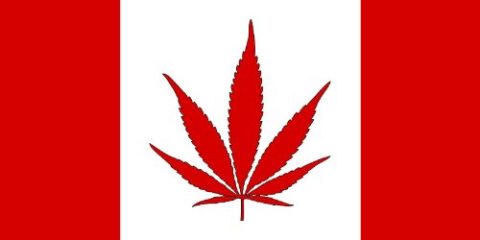
The move toward marijuana legalization is … still not as coherent as it could be, let’s say. The Liberal legislation, unveiled last month, would establish rules around THC-impaired driving that may well prove unconstitutional: science has yet to establish a solid link between a given level of THC concentration in a driver’s blood or saliva and his level of impairment. Frustratingly, there are still those who use this as an argument against legalization — as if it would create pot-impaired drivers where there are none today.
Last week on CTV’s Question Period, host Evan Solomon asked former U.S. ambassador Bruce Heyman what would happen if someone showed up to the border with his car or his clothes smelling of marijuana. It’s a variation of a question that’s been asked often: As it stands, Canadians who admit having smoked marijuana in the past are sometimes turned back. What would happen after legalization?
The de facto answer is, as always: Whatever the hell the U.S. border guard in question wants to happen. (It amazes me how many Canadians haven’t yet figured this out.) And furthermore: “Don’t rock up to the U.S. border reeking of pot, you utterly unsympathetic tool.”
The de jure answer: Well, who knows? Why would Canada’s decision to legalize marijuana have any bearing on the admissibility of foreign pot-smokers to the United States of America?
Heyman’s answers were more, er, nuanced than mine. Bafflingly, he started talking about sniffer dogs and their performance limitations: They won’t care that pot’s legal, so they’ll still detect marijuana, and that will bog down the border.
Now, marijuana legalization certainly might lead to a bogged-down border — if humans, not canines, decide to bog it down. For example, one can imagine Donald Trump thinking legalization necessitated much more aggressive screening of incoming motorists, and not caring too much about the trade implications. Whether that makes any sense is another question.
May 6, 2017
Supreme Court to review Prohibition-era inter-provincial alcohol regulations
Alan White reports that the Supreme Court of Canada has agreed to hearing an appeal of a New Brunswick court decision:
The Supreme Court of Canada has agreed to hear an appeal of a New Brunswick court ruling that declared it unconstitutional to limit the amount of alcohol someone can bring into the province.
At the centre of the case is Gerard Comeau of Tracadie, N.B. He was acquitted by a provincial court judge of exceeding provincial importation limits on beer and liquor that can be brought into New Brunswick.
Comeau was charged in 2012. RCMP had stopped him after he entered New Brunswick from Quebec with 14 cases of beer and three bottles of liquor. New Brunswick’s Liquor Control Act sets a personal importation limit of 12 pints of beer or one bottle of alcohol or wine.
Provincial court Judge Ronald LeBlanc ruled the liquor restriction was unconstitutional because Sec. 121 of the 1867 Constitution states products from any province “shall … be admitted free into each of the other provinces.”
Lawyer Ian Blue, who acted as part of Comeau’s defence team on behalf of the Canadian Constitution Foundation, says the case stands to have major implications.
Blue said the federal and provincial governments are currently discussing trade matters pertaining to NAFTA, milk marketing boards, softwood lumber tariffs, but “they’re not looking at this Comeau case.”
“This Comeau case, with the Supreme Court decision, could have more profound effects on interprovincial trade barriers than President Trump could,” said Blue. “That’s how important this case is.”
March 31, 2017
The likely impact of legalized marijuana on healthcare costs
Colby Cosh, a self-confessed hardcore druggie (okay, he admits “I’m not a big pot smoker, although it is a point of honour with me to admit in print that I have done it plenty of times”), on some interesting aspects of next year’s “Cannabis Day” legalization target:
What leapt out at me in [recently elected MP and former cop Glen] Motz’s stream of consciousness was a claim that “health-care costs are starting to rise” in the recreational-marijuana states. What could this mean? The U.S. doesn’t have single-payer universal public healthcare, and its programs for the poor, the aged, and veterans are all administered federally. But if Motz wants to bring up health-care costs, we can certainly go there.
They found that when individual states legalized medical marijuana (as 28 now have), doctors in those states began to fill fewer prescriptions addressing medical conditions for which there is some evidence that marijuana might help — anxiety, nausea, seizures, and the like
One of the most remarkable economic findings of any kind on piecemeal marijuana acceptance in the U.S. appeared in the journal Health Affairs last July. It became famous almost immediately as the “Medicare Part D study”: two policy specialists at the University of Georgia in Athens looked at data on 87 million pharmaceutical prescriptions paid for by the federal government from 2010 to 2013. They found that when individual states legalized medical marijuana (as 28 now have), doctors in those states began to fill fewer prescriptions addressing medical conditions for which there is some evidence that marijuana might help — anxiety, nausea, seizures, and the like.
By “fewer” I mean “a lot fewer.” The study estimated, for example, that medical marijuana reduced prescriptions for pain medication by about 1,800 per physician per year. That estimate could be off by an order of magnitude and still be pretty impressive. It is only one study, but when the researchers double-checked their results by looking at conditions that nobody thinks marijuana is indicated for, they found no declines in prescribing.
Marijuana is still an outlawed Schedule I drug under U.S. federal law, doctors even in medical-marijuana states “recommend” the stuff rather than formally prescribing it, and patients have to pay for it. Moreover, pot may be relatively unpopular with the (mostly pension-age) Medicare-eligible population. The Medicare Part D study shows, if nothing else, that American medicine is already making heavy professional use of marijuana. The authors think it might have saved Medicare half a billion dollars over the four-year study period. Perhaps there are concomitant harms that this study does not account for. It is hard for me to imagine what they might be, but I am not a politician.

